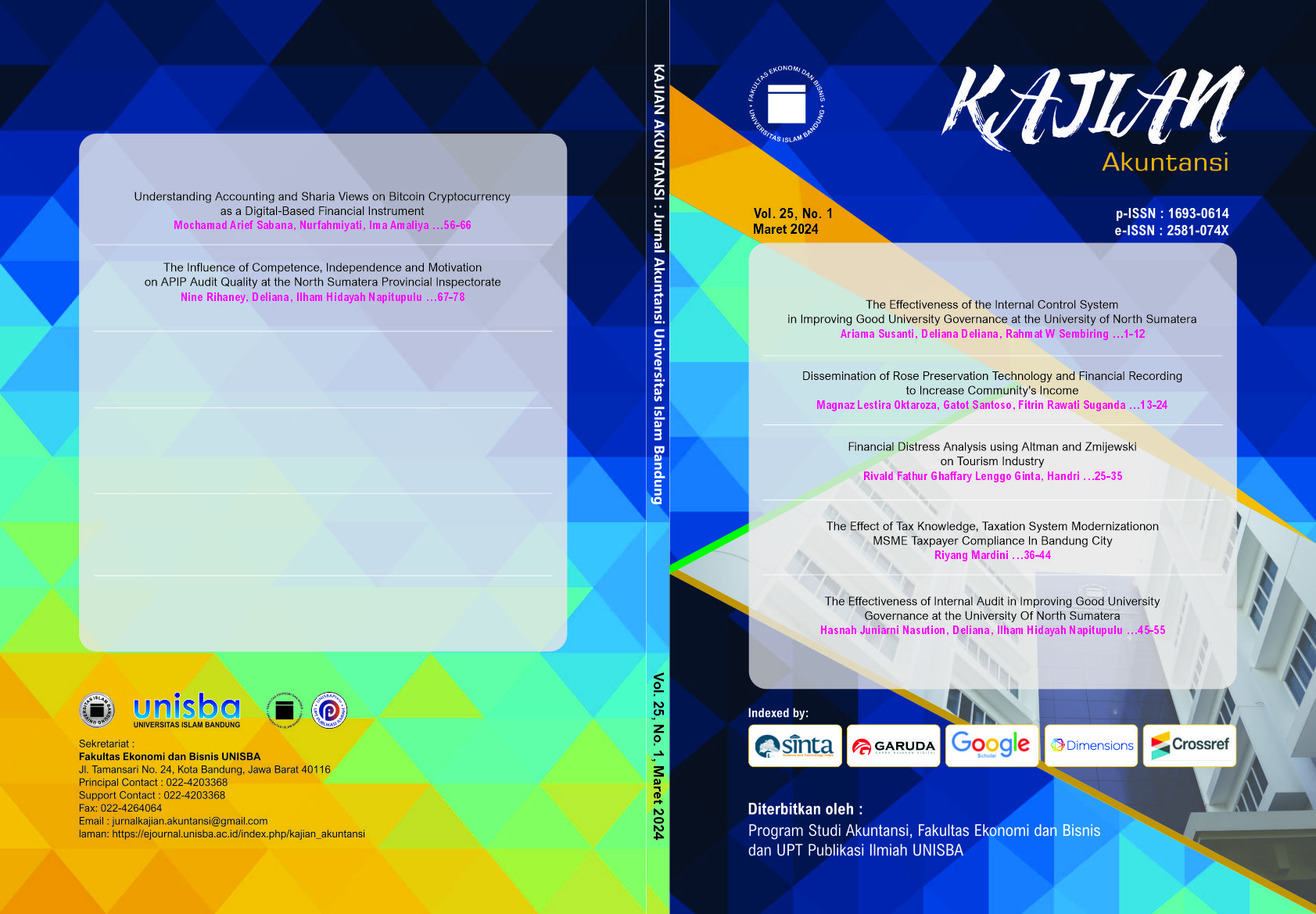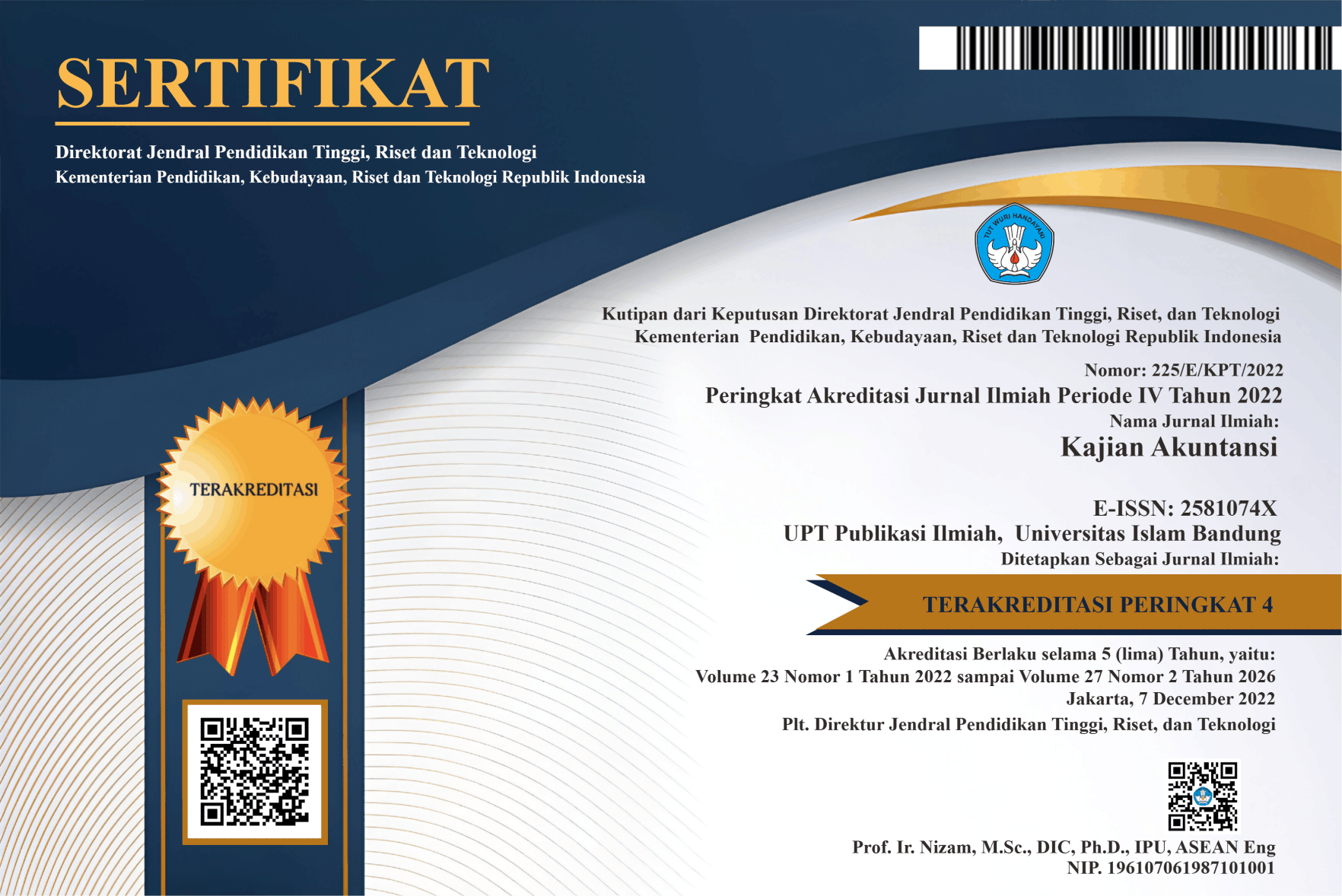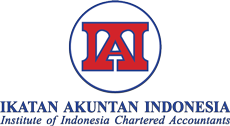FINANCIAL DISTRESS ANALYSIS USING ALTMAN AND ZMIJEWSKI ON TOURISM INDUSTRY
DOI:
https://doi.org/10.29313/kajian_akuntansi.v25i1.3303Abstract
This study examines financial distress scenarios in the tourism and recreation industry using the Altman Z-score and Zmijewski X-Score methodologies. Employing a quantitative descriptive research approach with purposive sampling, the study analyzes 12 publicly listed companies on the Indonesia Stock Exchange from 2019 to 2022. The results indicate that PT. Eastparc Hotel is the most financially stable, contrasting with PT. Bukit Uluwatu Villa as the weakest. While both methods yield different results, the disparity is not highly significant due to the varied components analyzed in the financial reports. The research recommends using multiple analytical methods for bankruptcy prediction to allow for accuracy assessment and to determine the suitability of each model for specific companies.
Keywords : Financial distress, Tourism and recreation industry, Z-score altman, zmijewski x-score.
References
www.idx.com
Central Statistics Agency (BPS)
Jr, J. S., & Dugan, M. T. (2003). Re-estimations of the Zmijewski and Ohlson bankruptcy prediction models. Advances in Accounting, 20, 77-93.
Ika, S. R., Udin, K., Nugroho, J. P., & Koenti, I. J. (2021, March). Assessing the Financial Performance of English Football Clubs: Arsenal and Manchester City. In The 3rd International Conference on Banking, Accounting, Management and Economics (ICOBAME 2020) (pp. 57-62). Atlantis Press.
Nafiisa, B. L., Eltivia, N., & Budisanto, S. (2022). Comparative Accuracy Level Analysis of Altman Z-Score, Zmijewski, and Tafller's. InAnnual Management, Business and Economics Conference(Vol. 4, No. 1, pp. 115-120).
Manalu, S., Octavianus, R. J. N., & Kalmadara, G. S. S. (2017). Financial distress analysis with Altman z-score approach and Zmijewski x-score on the shipping service company. Journal of Management Applications, 15(4), 677-682.
Copeland, T. E., Weston, J. F., & Shastri, K. (2005). Financial theory and corporate policy (Vol. 4). Boston: Pearson Addison Wesley.
Caouette, J. B., Altman, E. I., Narayanan, P., & Altman, Z. (1968). 1.6 Z-score estimated for non-manufacturers & emerging markets. Altman Z-Score, 189(1).
Altman, E. I. (1983). Exploring the road to bankruptcy. Journal of Business Strategy, 4(2), 36-41.
Yendrawati, R., & Adiwafi, N. (2020). Comparative analysis of Z-score, Springate, and Zmijewski models in predicting financial distress conditions. Journal of Contemporary Accounting, 72-80.
Alcalde, R., Alonso de Armiño, C., & García, S. (2022). Analysis of the economic sustainability of the supply chain sector by applying the Altman Z-score predictor. Sustainability, 14(2), 851.
Sareen, A., & Sharma, S. (2022). Assessing financial distress and predicting stock prices of automotive sector: robustness of Altman Z-score. Vision, 26(1), 11-24.
Creswell, J. W., & Creswell, J. D. (2017). Research design: Qualitative, quantitative, and mixed methods approaches (5th ed.). Sage publications.
Juliani, T., Rinofah, R., & Sari, P. P. (2022). Pengaruh Kinerja Keuangan terhadap Financial Distress pada Perusahaan Manufaktur Sub Sektor Industri Barang Konsumsi Makanan dan Minuman yang Terdaftar di Bursa Efek Indonesia Periode 2016-2020. Al-Kharaj: Jurnal Ekonomi, Keuangan & Bisnis Syariah, 4(3), 726-744.
Primasari, N. S. (2017). Analisis Altman Z-Score, Grover Score, Springate, Dan Zmijewski Sebagai Signaling Financial Distress (Studi Empiris Industri Barang-Barang Konsumsi Di Indonesia). Accounting and Management Journal, 1(1).
Colline, F. (2020, September). Bankruptcy prediction analysis: A case study of retail companies in Indonesia. In International Conference on Management, Accounting, and Economy (ICMAE 2020) (pp. 326-330). Atlantis Press.
Nazareth, N., & Reddy, Y. Y. R. (2023). Financial applications of machine learning: A literature review. Expert Systems with Applications, 119640.
Zmijewski, M. E. (1984). Methodological issues related to the estimation of financial distress prediction models. Journal of Accounting research, 59-82.
Platt, H. D., & Platt, M. B. (2002). Predicting corporate financial distress:Reflections on choice-based sample bias. Journal of economics and finance, 26(2),184-199.
Al‐Hadi, A., Chatterjee, B., Yaftian, A., Taylor, G., & Monzur Hasan, M. (2019). Corporate social responsibility performance, financial distress and firm life cycle: evidence from Australia. Accounting & Finance, 59(2), 961-989.
Rahmayanti, S., & Hadromi, U. (2017). Analisis financial distress pada perusahaan manufaktur yang terdaftar di Bursa Efek Indonesia. Jurnal Akuntansi dan ekonomika, 7(1), 53-63.
Nurhayati, N., Nurcholisah, K., & Aprian, T. (2019). Pengaruh Sales Growth dan Keahlian Keuangan Komite Audit terhadap FinancialDistress.(Studi Empiris Pada Perusahaan Manufaktur Sub Sektor Otomotif dan Komponen yang Terdaftar di Bursa Efek IndonesiaPeriode 2012-2016). Kajian Akuntansi, 20(1), 80-86.
Latif, E. F., & Triyanto, D. N. (2018). Analiis Faktor-faktor yang Mempengaruhi Kemungkinan Terjadinya Financial Distress (Studi pada Perusahaan Sektor Pertambangan yang Terdaftar di Bursa Efek Indonesia Periode 2012-2016). Kajian Akuntansi, 19(2), 137-144.
Usmany, P., & Loupatty, L. G. (2021). Analisis Potensi Kebangkrutan Sebagai Dampak Pandemi Covid-19 Pada Perusahaan Sub Sektor Restoran, Hotel Dan Pariwisata Di Bursa Efek Indonesia. Fair Value: Jurnal Ilmiah Akuntansi Dan Keuangan, 4(Spesial Issue 2), 603-615.
Firdayanti, F. (2022). ANALISIS FINANCIAL DISTRESS PADA SEKTOR KEPARIWISATAAN YANG TERDAFTAR DI BURSA EFEK INDONESIA (STUDI PADA PERIODE TAHUN 2020) (Doctoral dissertation, Universitas Islam Kalimantan MAB).
Boronenkova, S. A., Mironova, O. A., & Popov, A. Y. (2020, January). Assessment of Liquidity Ratios as Indicators of an Organization’s Economic Security: Accounting Aspects. In First International Volga Region Conference on Economics, Humanities and Sports (FICEHS 2019) (pp. 156-160). Atlantis Press.
Sholatika, N. I. (2022, June). The Effect of Profitability, Liquidity and Leverage on Company Value with Dividend Policy as Moderating Variables on Consumer Companies Listed on the Indonesia Stock Exchange 2018-2020. In International Conference on Economics and Business Studies (ICOEBS 2022) (pp. 343-350). Atlantis Press.
Medvedeva, T. (2020, January). Assessment of solvency and financial stability of agricultural consumer cooperatives. In Ecological-Socio-Economic Systems: Models of Competition and Cooperation (ESES 2019) (pp. 331-335). Atlantis Press.















